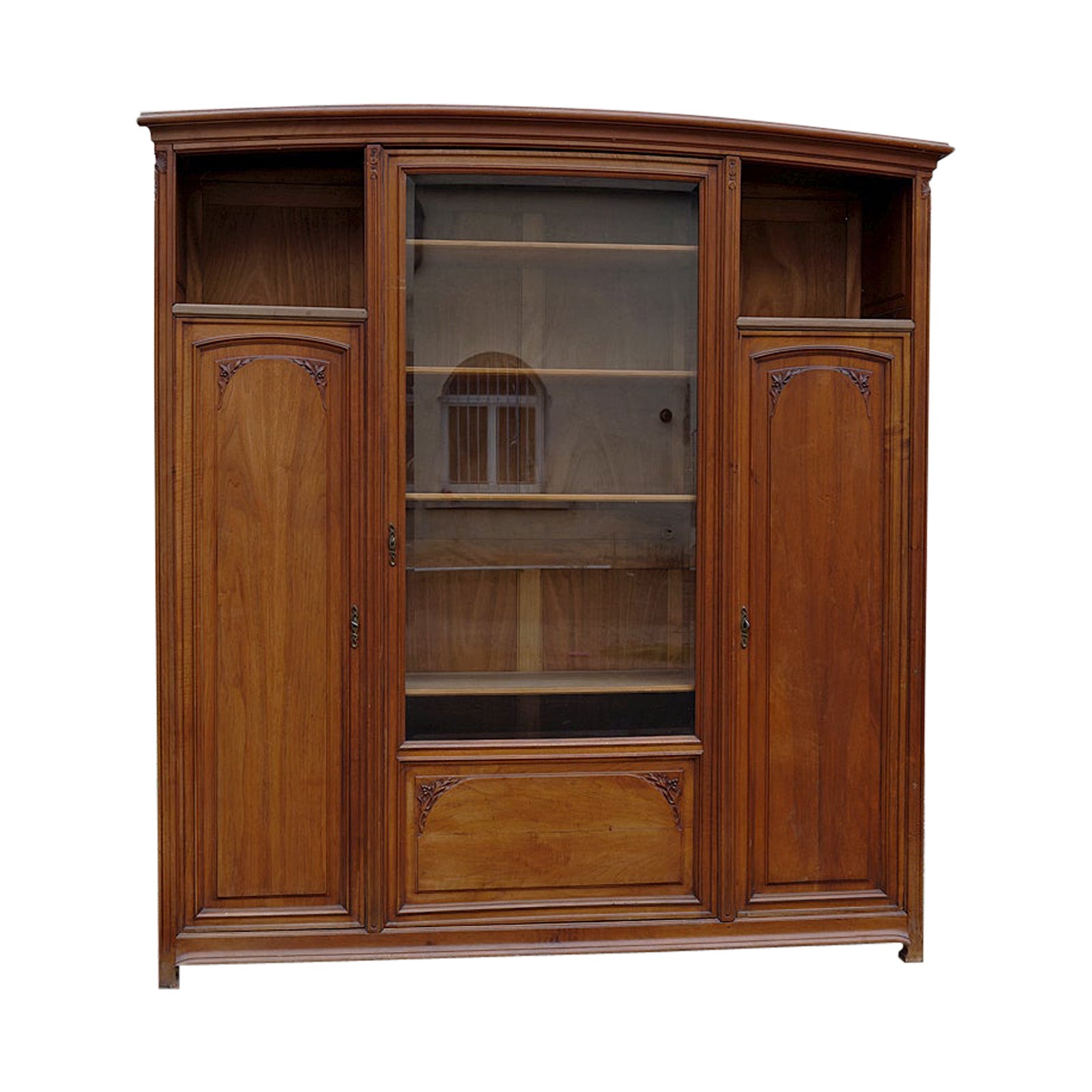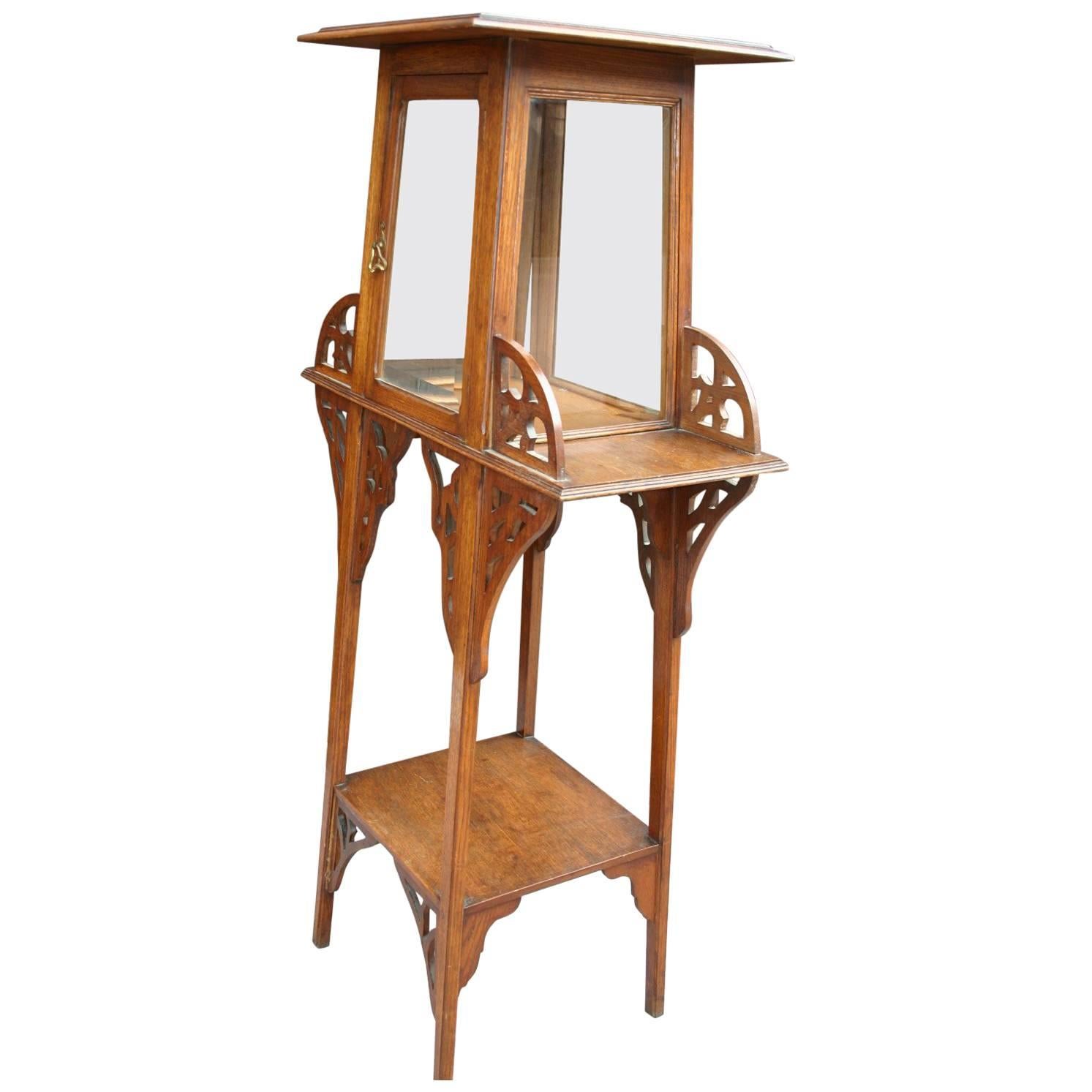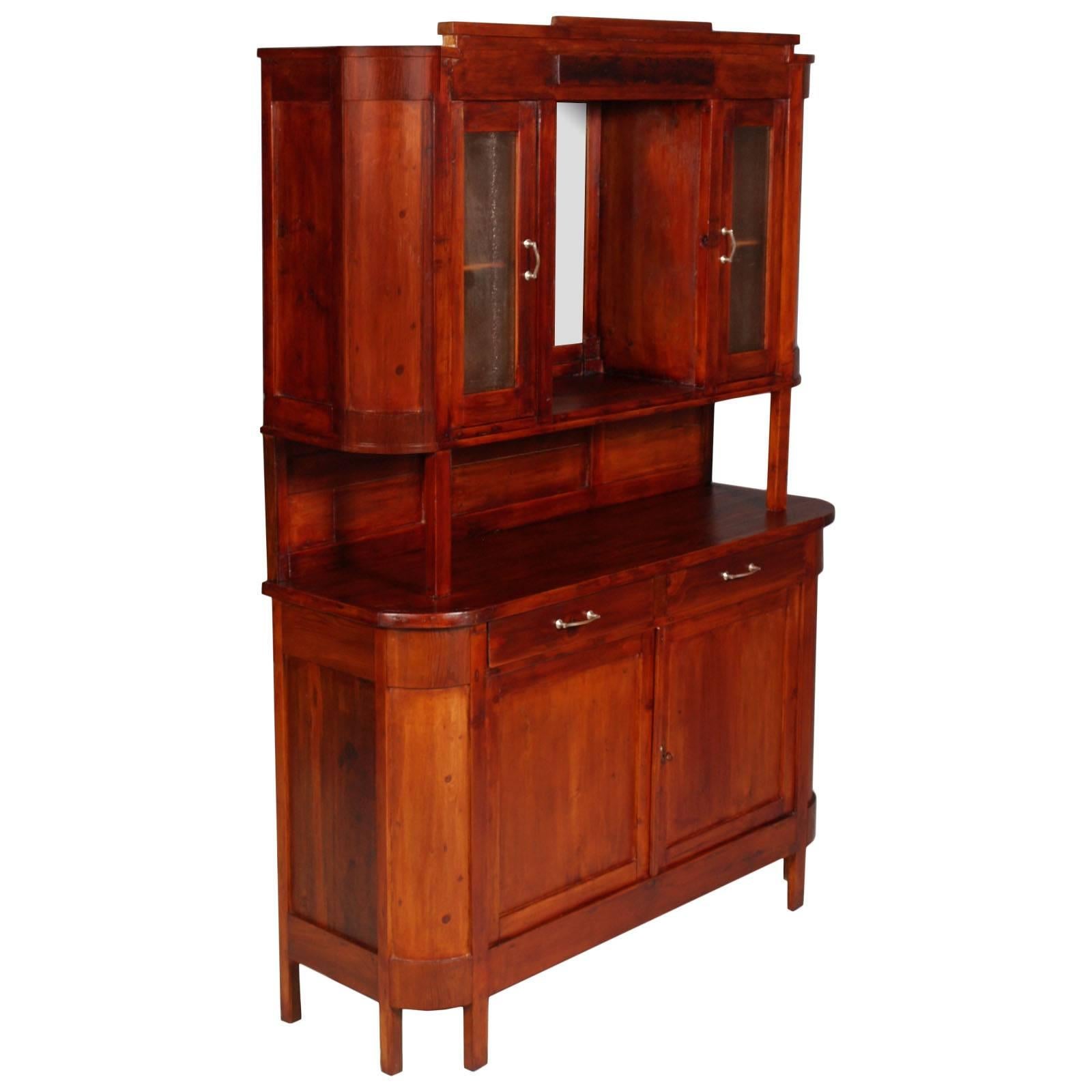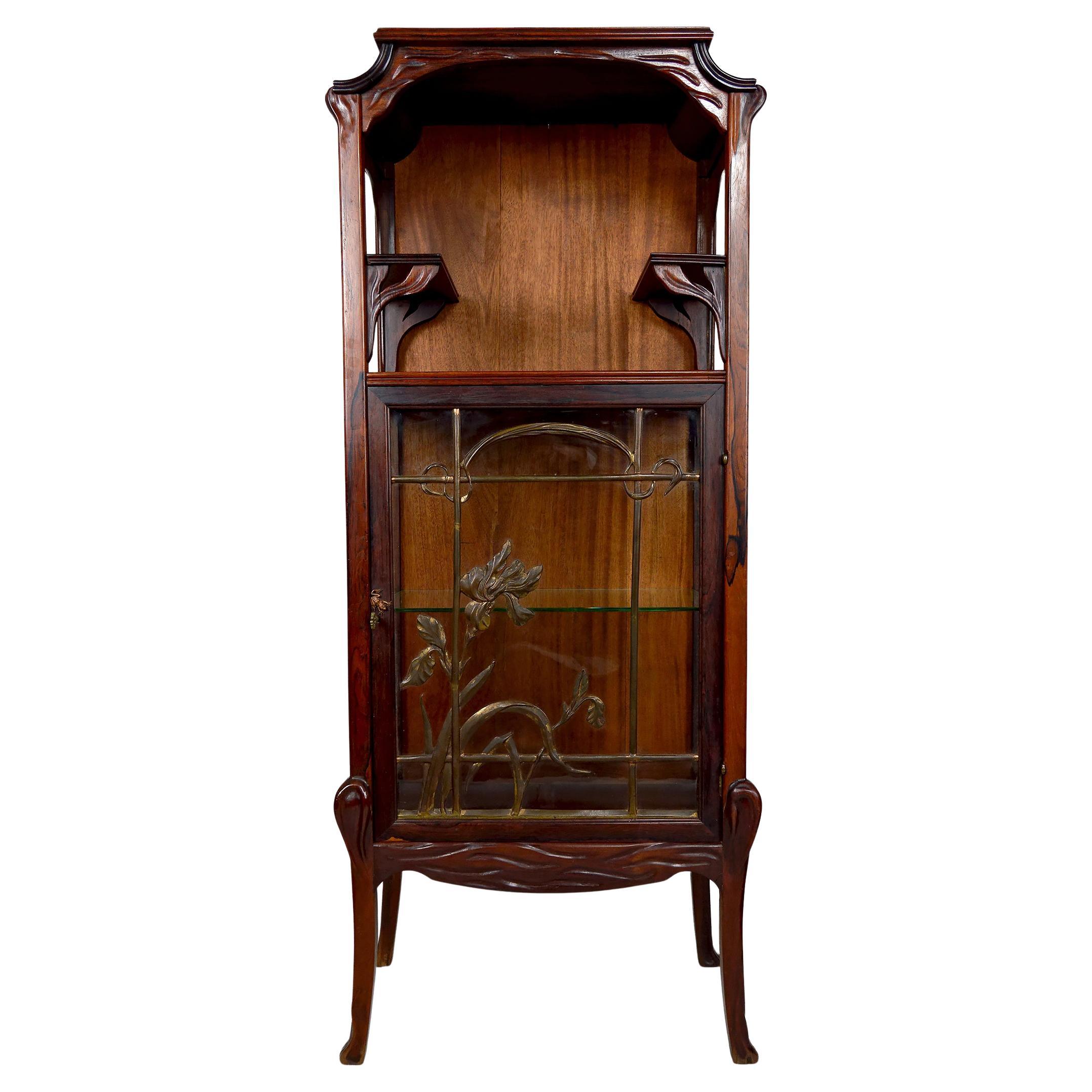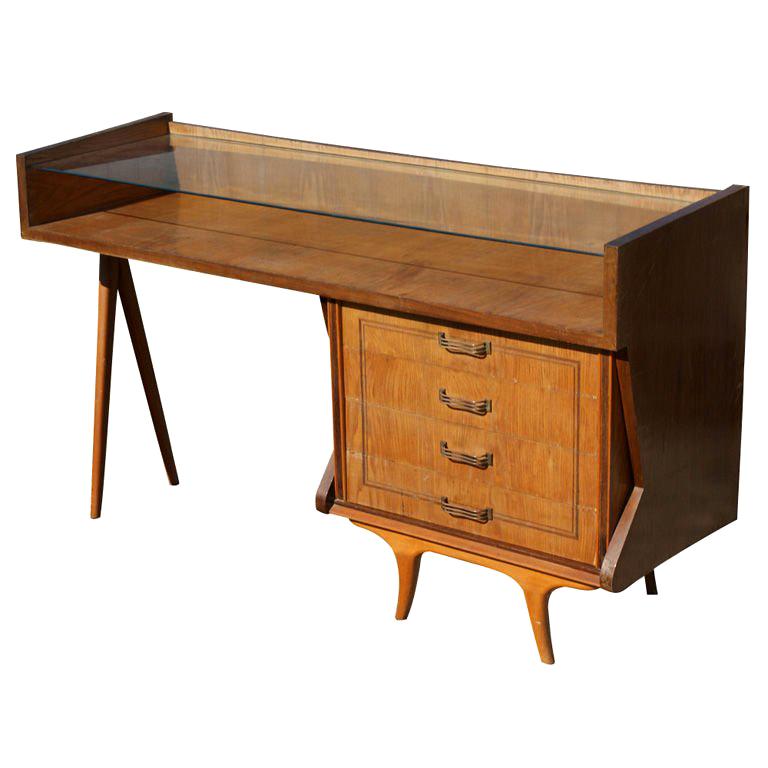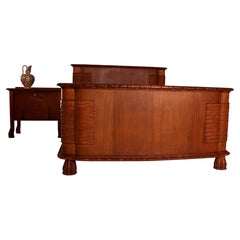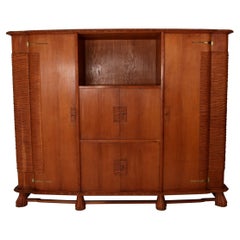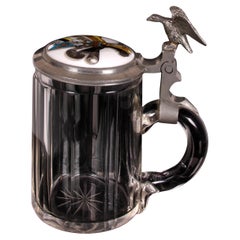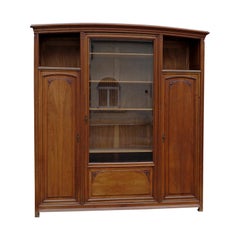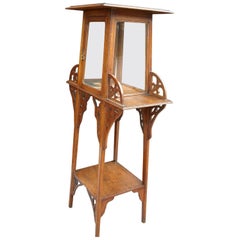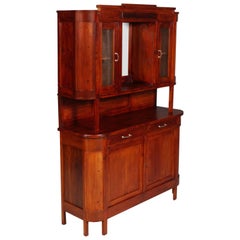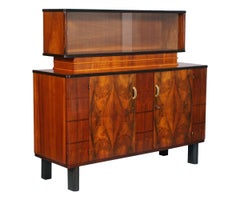Items Similar to Bespoke Burl Wooden Art Nouveau Display Glass Cabinet H. Pössenbacher Est. 1784
Want more images or videos?
Request additional images or videos from the seller
1 of 20
Bespoke Burl Wooden Art Nouveau Display Glass Cabinet H. Pössenbacher Est. 1784
About the Item
A bespoke display cabinet, crafted by one of Munich's most distinguished cabinet makers, Heinrich Pössenbacher, during the early 20th century (specifically between 1908 and 1918).The piece of furniture, which is in remarkably pristine condition, was commissioned by a family residing in the Bogenhausen district of Munich. It was part of a suite that included a credenza, two side tables, and a substantial dining table accompanied by six chairs, which has already been sold.
The tables and chairs are currently located in an apartment in Schloss Schönbrunn in Vienna, and the substantial credenza is in a prestigious residence in Zehlendorf, Berlin.This exceptional piece, which remains available, consists of two components: an upper display cabinet and a base, both of which are notably substantial in weight.The cabinet is veneered with premium walnut burl wood, and features intricate Intarsia work with Jugendstil ornaments. The lower base and legs are elegantly framed by a wooden trim.
These pieces are considered to be among the most exquisite and meticulously crafted examples in existence.The exceptional condition of the furniture is attributed to its minimal usage since the early 1960s, when it was situated in a living room on a farmstead belonging to a family member of the original owners. The furniture was covered with blankets throughout this period. It was by chance that the owner revealed the existence of the drawings after a conversation, having previously neglected to mention them.Each piece of furniture has been accompanied by an artistic rendering, providing a visual representation of its intended appearance. The cabinet's drawing will be included in the portfolio, allowing the new owner the option of framing it according to their preferences.
Pössenbacher artistic cabinetmakers have a tradition through 5 generations!
The history of the Pössenbacher company can be traced back to its origins in the eighteenth century, when Matthaeus Pössenbacher, great-great-grandfather of the current proprietor, began manufacturing furniture for Architect François de Cuvilliés.
The company Pössenbacher was founded by Mathias Pössenbacher (son of Matthaeus and great-grandfather of Heinrich) in 1784.
The following is a list of notable members of this remarkable family:
Matthaeus Pössenbacher (documented in the 1770s), German cabinetmaker
Mathias Pössenbacher, German architect
Joseph Pössenbacher (1799-1873), German furniture manufacturer, court cabinetmaker
Anton Pössenbacher (1842-1920), German furniture manufacturer
Heinrich Pössenbacher (1877-1959), German furniture manufacturer
A substantial research project was conducted by contacting two experts from the Stadtmuseum München in order to ascertain the facts. It was found that the experts would have purchased all the pieces from this bespoke set if they had sufficient space in their museum.
Heinrich Anton Josef Pössenbacher (* 3 May 1877 in Munich; † 10 August 1959) was a leading German furniture manufacturer.
Early life
The son of court cabinetmaker and furniture maker Anton Pössenbacher, he studied at the Technical University of Munich before joining his father's business.
"During a stay in England, which had a lasting influence on Pössenbacher's furniture style, he met the architect John Archibald Campbell (1878-1947) and persuaded him to come to Munich as a designer.
in 1901. In 1902 the company moved to new premises on the corner of Brienner Strasse and Wittelsbacher Platz, which were "richly furnished by Campbell".
That same year, Heinrich Pössenbacher took over his father's luxury furniture factory, which he expanded in 1927 with the addition of a machine shop and a new workshop.
. Under his management, the Pössenbacher workshops carried out prestigious commissions, including furnishing the steamships Milwaukee (1928) and Europa (1929).
of the Hapag-Lloyd shipping company.
Contacts in the Rhineland led to the interior design of the Grand Hotel Petersberg near Königswinter (1914 and 1922).
- and, in 1920, his second marriage to Emilie Mülhens, a daughter of the hotel owner and Cologne entrepreneur Ferdinand Mülhens.
The economic difficulties of the period after the First World War led to the closure of the shop at Brienner Strasse 55 in 1925.
In the same year, Heinrich Pössenbacher took over his father's luxury furniture factory, which he expanded in 1927 by building a machine hall and a new workshop
. Under his management, the Pössenbacher workshops carried out prestigious commissions, including furnishings for the steamships Milwaukee (1928) and Europa (1929)
of the Hapag Lloyd shipping company.
Contacts made in the Rhineland led to the interior design of the Grandhotel Petersberg near Königswinter (1914 and 1922)
- and in 1920 to his second marriage to Emilie Mülhens, a daughter of the hotel owner and Cologne entrepreneur Ferdinand Mülhens.
The economic difficulties in the period after the First World War led to the closure of the salesrooms at Brienner Strasse 55 in 1925.
World Exhibition Paris 1937
The World Exhibition in Paris in 1937 is a pertinent point of reference. Heinrich Pössenbacher's sons, Otto (born 1907) and Fritz (born 1906), assumed responsibility for the management of the company in succession. Otto assumed responsibility for the commercial division, while Fritz took charge of artistic matters.In 1935, Heinrich Pössenbacher commissioned the construction of a country residence in Berg on Lake Starnberg, the design of which was inspired by his own personal vision.
The company survived the Second World War, and although parts of the factory and the entire timber warehouse were destroyed by bombs, everything was completely rebuilt.
However, the company's financial viability was impacted by the erosion of market share in the luxury furnishings sector, the emergence of mass production methods, and the proliferation of craft businesses. Consequently, Heinrich Pössenbacher and his sons Fritz and Otto made the decision to divest the complex at Jahnstraße 45 to Elektrotechnische Fabrik Alois Zettler GmbH in 1951.
Pössenbacher attended the Royal School of Arts and Crafts in Munich, where his tutors included H. Dyck and J. Knabl. Thereafter, he pursued a career as a carpenter and draughtsman in Vienna, Berlin, Cologne, Paris and London from 1860 to 1863. In 1866, he assumed control of his father's carpentry business for a sum of 10,000 guilders, and in 1873, he acquired a property spanning two acres, equipped with water power, from a master carpenter at Baumstraße 3 (subsequently Jahnstraße 45) in Munich. This property was expanded by Pössenbacher into a substantial furniture manufacturing facility.His enterprise emerged as a European leader in the production of luxury furniture during the 19th century. Notably, he furnished the royal flats of Linderhof, Herrenchiemsee and Neuschwanstein castles with furniture created according to the specifications of King Ludwig II, as well as his own designs.He also produced furnishings for the Munich Residence and Trausnitz Castle in my hometown Landshut (ex Capital of Bavaria from 1204 to 1253 ).
In 1886/87, he furnished a library hall in Bucharest Palace for King Charles I according to his own designs, and he created the restoration hall for the Reichstag building based on a design by Paul Wallot. For other clients, such as manufacturers, merchants and landowners, he usually supplied entire room furnishings for their townhouses and villas.
Anton Pössenbacher (born 6 October 1842 in Munich, Kingdom of Bavaria; died 4 July 1920 in Munich, Free State of Bavaria) was a leading Munich court cabinetmaker and manufacturer of court furniture in the historicist style.Anton Pössenbacher (born 6 October 1842 in Munich, Kingdom of Bavaria; died 4 July 1920 in Munich, Free State of Bavaria) was a leading Munich court cabinetmaker and manufacturer of court furniture in the historicist style.
Anton Pössenbacher's father, Joseph Pössenbacher (1799-1873), had a furniture workshop in Munich that supplied the Bavarian royal court.
The workshop had been founded in 1784 by his father, the architect Mathias Pössenbacher. Matthäus Pössenbacher (documented in the 1770s) made furniture for the Munich architect François de Cuvilliés.
Anton Pössenbacher was awarded the title of Royal Court Furniture Manufacturer and Councillor of Commerce. He collaborated with Gabriel von Seidl and his childhood friend Rudolf Seitz to revive the Renaissance style. His furniture factory was subsequently taken over by his son, Heinrich Pössenbacher.
DEUTSCH:
Heinrich Anton Josef Pössenbacher (* 3. Mai 1877 in München; † 10. August 1959) war ein führender deutscher Möbelfabrikant.
Leben
Der Sohn des Hofschreiners und Hofmöbelfabrikanten Anton Pössenbacher besuchte die Technische Hochschule München und trat dann in das Unternehmen seines Vaters ein.
„Bei einem Aufenthalt in England, der Pössenbachers Möbelstil nachhaltig beeinflusste, lernte er den Architekten John Archibald Campbell (1878–1947) kennen und bewegte ihn,
1901 als Entwerfer nach München zu kommen. 1902 erfolgte ein Umzug in neue, reich von Campbell ausgestattete Verkaufsräume an der Ecke Brienner Straße / Wittelsbacher Platz.“
Im selben Jahr übernahm Heinrich Pössenbacher von seinem Vater dessen Fabrik für Luxusmöbel, die er 1927 vergrößerte, indem er eine Maschinenhalle und eine neue Werkstätte
errichtete. Unter seiner Leitung führten die Pössenbacher Werkstätten repräsentative Aufträge aus, darunter Ausstattungen für die Dampfer Milwaukee (1928) und Europa (1929)
der Reederei Hapag Lloyd.
Im Rheinland geknüpfte Kontakte führten zur Ausführung von Innenausstattungen des Grandhotels Petersberg bei Königswinter (1914 und 1922)
– und 1920 zu seiner zweiten Ehe mit Emilie Mülhens, einer Tochter des Hotelbesitzers und Kölner Unternehmers Ferdinand Mülhens.
Die wirtschaftlichen Schwierigkeiten in der Zeit nach dem Ersten Weltkrieg führten 1925 zur Aufgabe der Verkaufsräume im Haus Brienner Straße 55.
Weltausstellung Paris 1937
In der Geschäftsleitung wurde Heinrich Pössenbacher sukzessive durch seine Söhne vertreten: Otto (* 1907) im kaufmännischen Bereich und Fritz (* 1906)
in künstlerischen Belangen. 1935 ließ sich Heinrich Pössenbacher ein stilvolles Landhaus in Berg am Starnberger See nach eigenen Plänen bauen.
Es waren nicht die direkten Zerstörungen des Zweiten Weltkriegs, die zum Ende des Traditionsunternehmens führten.
Obwohl Teile der Fabrikanlagen und das ganze Holzlager durch Bomben zerstört worden waren, wurde alles vollständig wiederaufgebaut.
Aber der Wegfall wichtiger Märkte im Bereich von Luxusausstattungen, die fortschreitende Serienfabrikation und die Vermehrung der Handwerksbetriebe ließ die Gewinne schmelzen,
so dass Heinrich Pössenbacher und seine beteiligten Söhne Fritz und Otto 1951 den Verkauf des Komplexes Jahnstraße 45 an die Elektrotechnische Fabrik Alois Zettler GmbH
beschlossen.
____________________________________________________________________________
Der Vater: Anton Pössenbacher (* 6. Oktober 1842 in München, Königreich Bayern; † 4. Juli 1920 in München, Freistaat Bayern) war ein führender Münchner Hofschreiner und Hofmöbelfabrikant im Stil des Historismus.
Anton Pössenbachers Vater Joseph Pössenbacher (1799–1873) hatte in München eine Möbelmanufaktur, die den bayrischen Königshof belieferte.
Die Werkstatt war von dessen Vater, dem Architekten Mathias Pössenbacher 1784 gegründet worden. Dessen Vater Matthaeus Pössenbacher (nachweisbar in den 1770er Jahren) stellte Möbel für den Münchner Architekten François de Cuvilliés her.
Pössenbacher besuchte die Königliche Kunstgewerbeschule München. Seine Lehrer waren u. a. H. Dyck und J. Knabl. Anschließend arbeitete er von 1860 bis 1863 in Wien,
Berlin, Köln, Paris und London als Schreiner und Zeichner. 1866 übernahm er die Schreiner-Gerechtsame seines Vaters um 10.000 Gulden und erwarb 1873
von einem Zimmermeister ein zwei Tagwerk großes Anwesen mit Wasserkraft in der Baumstraße 3 (später Jahnstraße 45) in München, welches er zu einer großen Möbelfabrik ausbaute.
Sein Unternehmen war im 19. Jahrhundert in der Fertigung von Luxusmöbeln europaweit führend. Insbesondere stattete er die königlichen Appartements der Schlösser Linderhof,
Herrenchiemsee und Neuschwanstein mit Möbeln aus, die nach den Wünschen König Ludwigs II., aber auch nach eigenen Zeichnungen schuf.
Auch für die Münchner Residenz und für die Burg Trausnitz fertigte er Einrichtungsgegenstände.
1886/87 möblierte er einen Bibliothekssaal im Bukarester Schloss für König Karl I. nach eigenen Entwürfen, den Restaurationssaal für das Reichstagsgebäude schuf er nach einem
Entwurf von Paul Wallot. Für weitere Auftraggeber wie Fabrikanten, Kaufleute und Gutsbesitzer lieferte er für deren Stadthäuser und Villen zumeist ganze Raumausstattungen.
Anton Pössenbacher erhielt den Titel eines Kgl. Hofmöbelfabrikanten und Kommerzienrates. Er setzte sich mit Gabriel von Seidl und dessen Jugendfreund Rudolf Seitz
für die Wiederbelebung des Renaissancestils ein.
Seine Möbelfabrik wurde von seinem Sohn Heinrich Pössenbacher übernommen.
- Attributed to:Moritz Ballin (Cabinetmaker)
- Dimensions:Height: 71.66 in (182 cm)Width: 67.33 in (171 cm)Depth: 23.23 in (59 cm)
- Style:Art Nouveau (Of the Period)
- Materials and Techniques:
- Place of Origin:
- Period:1910-1919
- Date of Manufacture:1908-1918
- Condition:
- Seller Location:Landshut, DE
- Reference Number:1stDibs: LU8587234300522
About the Seller
5.0
Gold Seller
Premium sellers maintaining a 4.3+ rating and 24-hour response times
1stDibs seller since 2023
20 sales on 1stDibs
Typical response time: 2 hours
- ShippingRetrieving quote...Shipping from: Bodenkirchen , Germany
- Return Policy
Authenticity Guarantee
In the unlikely event there’s an issue with an item’s authenticity, contact us within 1 year for a full refund. DetailsMoney-Back Guarantee
If your item is not as described, is damaged in transit, or does not arrive, contact us within 7 days for a full refund. Details24-Hour Cancellation
You have a 24-hour grace period in which to reconsider your purchase, with no questions asked.Vetted Professional Sellers
Our world-class sellers must adhere to strict standards for service and quality, maintaining the integrity of our listings.Price-Match Guarantee
If you find that a seller listed the same item for a lower price elsewhere, we’ll match it.Trusted Global Delivery
Our best-in-class carrier network provides specialized shipping options worldwide, including custom delivery.More From This Seller
View AllColli Torino (Est. 1850) Art Nouveau Italian Corner Cabinet Wardrobe Solid Oak
By Colli Torino
Located in Landshut, BY
This corner wardrobe was produced by Colli Torino established in 1850.
- solid oak with hand carved elements and beautiful brass fittings with its original key -
The company is we...
Category
Vintage 1910s Italian Art Nouveau Cupboards
Materials
Brass
Colli Torino 'Est. 1850 ' Italian Art Nouveau Bed & Nightstand Solid Oak carved
By Colli Torino
Located in Landshut, BY
This bed and night stand was produced by Colli Torino established in 1850.
- solid oak with hand-carved elements - mattress size is 120cm x 190cm -
The company is well known becau...
Category
Vintage 1910s Italian Art Nouveau Beds and Bed Frames
Materials
Oak
Wardrobe by Colli Torino Est 1850 Art Nouveau Huge Italian Solid Oak Masterpiece
By Colli Torino
Located in Landshut, BY
This wardrobe was produced by Colli Torino established in 1850.
- solid oak with hand-carved ornaments - beautiful brass fittings - with its original keys -
height: 195cms ~ width: 245cms ~ depth: 60cms ~ weight: ca. 360-400 Kg (!)
-: please have a closer look - which hopefully will make my fascination with this masterpiece comprehensible.
What also makes this wardrobe quite special is the 2 doors on each side covering compartments with narrow shelving...
Category
Vintage 1910s Italian Art Nouveau Wardrobes and Armoires
Materials
Brass
antique cut glass beer stein 1920s art nouveau with hand painted porcelain lid
Located in Landshut, BY
Antique glass beer jug with a pewter and porcelain lid
Hand painted by Ludwig Kannengießer
A commemorative gift from a university fraternity.
Southern Germany 1927
Ø 7.5 cm ~ Heig...
Category
Vintage 1920s German Art Nouveau Pitchers
Materials
Pewter
Art Nouveau Southern French Fayance art pottery FLOOR VASE rare colours&pattern
Located in Landshut, BY
A giving joy beautiful French Fayence Floor Vase
fantastic Art Nouveau pattern - Impressing Colours
Manufacturer unknown - marked
Design Period 1915 - 1925
Country of Manufacture : France
H / height: 46 cm ~ Gew. / weight: 4550 grs
DM / diameter max: 28 cm ~ DM oben / diameter inner rim: 19.8 cm
.... an ode to Southern France
A Legend of Provence
by Adelaide Anne Procter (30 October 1825 – 2 February 1864)
The lights extinguished, by the hearth I leant,
Half weary with a listless discontent.
The flickering giant-shadows, gathering near,
Closed round me with a dim and silent fear.
All dull, all dark; save when the leaping flame,
Glancing, lit up a Picture's ancient frame.
Above the hearth it hung. Perhaps the night,
My foolish tremors, or the gleaming light,
Lent power to that Portrait dark and quaint, —
A Portrait such as Rembrandt loved to paint, —
The likeness of a Nun. I seemed to trace
A world of sorrow in the patient face,
In the thin hands folded across her breast: —
Its own and the room's shadow hid the rest.
I gazed and dreamed, and the dull embers stirred,
Till an old legend that I once had heard
Came back to me; linked to the mystic gloom
Of that dark Picture in the ghostly room.
In the far south, where clustering vines are hung;
Where first the old chivalric lays were sung;
Where earliest smiled that gracious child of France,
Angel and knight and fairy, called Romance,
I stood one day. The warm blue June was spread
Upon the earth; blue summer overhead,
Without a cloud to fleck its radiant glare,
Without a breath to stir its sultry air.
All still, all silent, save the sobbing rush
Of rippling waves, that lapsed in silver hush
Upon the beach; where, glittering towards the strand
The purple Mediterranean kissed the land.
All still, all peaceful; when a convent chime
Broke on the mid-day silence for a time,
Then trembling into quiet, seemed to cease,
In deeper silence and more utter peace.
So as I turned to gaze, where gleaming white,
Half hid by shadowy trees from passers' sight,
The Convent lay, one who had dwelt for long
In that fair home of ancient tale and song,
Who knew the story of each cave and hill,
And every haunting fancy lingering still
Within the land, spake thus to me, and told
The Convent's treasured Legend, quaint and old: —
Long years ago, a dense and flowering wood,
Still more concealed where the white convent stood,
Borne on its perfumed wings the title came:
" Our Lady of the Hawthorns " is its name.
Then did that bell, which still rings out to-day,
Bid all the country rise, or eat, or pray.
Before that convent shrine, the haughty knight
Passed the lone vigil of his perilous fight;
For humbler cottage strife or village brawl,
The Abbess listened, prayed, and settled all.
Young hearts that came, weighed down by love or wrong,
Left her kind presence comforted and strong.
Each passing pilgrim, and each beggar's right
Was food, and rest, and shelter for the night.
But, more than this, the Nuns could well impart
The deepest mysteries of the healing art;
Their store of herbs and simples was renowned,
And held in wondering faith for miles around.
Thus strife, love, sorrow, good and evil fate,
Found help and blessing at the convent gate.
Of all the nuns, no heart was half so light,
No eyelids veiling glances half as bright,
No step that glided with such noiseless feet,
No face that looked so tender or so sweet,
No voice that rose in choir so pure, so clear,
No heart to all the others half so dear,
So surely touched by others' pain or woe,
(Guessing the grief her young life could not know,)
No soul in childlike faith so undefiled,
As Sister Angela's, the " Convent Child. "
For thus they loved to call her. She had known
No home, no love, no kindred, save their own.
An orphan, to their tender nursing given,
Child, plaything, pupil, now the Bride of Heaven
And she it was who trimmed the lamp's red light
That swung before the altar, day and night;
Her hands it was whose patient skill could trace
The finest broidery, weave the costliest lace;
But most of all, her first and dearest care,
The office she would never miss or share,
Was every day to weave fresh garlands sweet,
To place before the shrine at Mary's feet.
Nature is bounteous in that region fair,
For even winter has her blossoms there.
Thus Angela loved to count each feast the best,
By telling with what flowers the shrine was dressed.
In pomp supreme the countless Roses passed,
Battalion on battalion thronging fast,
Each with a different banner, flaming bright,
Damask, or striped, or crimson, pink, or white,
Until they bowed before a newborn queen,
And the pure virgin Lily rose serene.
Though Angela always thought the Mother blest
Must love the time of her own hawthorn best,
Each evening through the years, with equal care,
She placed her flowers; then kneeling down in prayer,
As their faint perfume rose before the shrine,
So rose her thoughts, as pure and as divine.
She knelt until the shades grew dim without,
Till one by one the altar lights...
Category
Vintage 1910s French Art Nouveau Vases
Materials
Pottery
$1,842 Sale Price
36% Off
art nouveau oak stool chair Jugendstil Rabenau embroidery a. 1910 exc condition
Located in Landshut, BY
solid built oak
Jugendstil
CHAIR
made in Rabenau / Saxonia
upholstered with care - fitted with hand embroidered jute fabric
Rabenau's chairmaking tradition is almost 400 years ol...
Category
Vintage 1910s German Art Nouveau Chairs
Materials
Wool, Jute, Oak
You May Also Like
Art Nouveau walnut bookcase / display cabinet, circa 1910
By Louis Majorelle, Atelier Majorelle
Located in VÉZELAY, FR
Art Nouveau walnut bookcase / display case, circa 1910
Attributed to Louis Majorelle
In carved walnut. Beveled glass door.
Locks + keys OK.
Pretty furnishing bronzes.
Bad conditi...
Category
Early 20th Century French Art Nouveau Vitrines
Materials
Glass, Wood, Walnut
$1,392 Sale Price
20% Off
Rare Jugendstil or Art Nouveau Etagere Table / Stand with Glass Display Cabinet
Located in Lisse, NL
Stylish and practical Art Nouveau table with built-in display cabinet.
This multi-layer and multipurpose piece of Art Nouveau furniture is a great example of the creative and elegan...
Category
Early 20th Century European Art Nouveau Vitrines
Materials
Glass, Wood
1900s Antique Credenza Sideboard Art Nouveau with Display Cabinet & Mirror
By Cucchi & Sola Ammobiliamenti Torino 1
Located in Vigonza, Padua
Code: FM32
Manufacturer: Cucchi - Sola Ammobigliamenti - Torino
Particular sideboard in two parts. Lower part, with the shelf and two large upper drawers, two doors and interior shel...
Category
Antique Late 19th Century Italian Art Nouveau Vitrines
Materials
Glass, Walnut
Italian Art Deco Credenza with display cabinet , Burl Walnut
By Strada Abramo
Located in Vigonza, Padua
Art deco credenza with display cabinet in burl walnut ,
by Ditta Strada Abramo fu Paolo, Milano, Italy.
Credenza with showcase in walnut with two bodies: sideboard with two doors ...
Category
Vintage 1920s Italian Art Deco Vitrines
Materials
Walnut, Burl
Art Nouveau Display Cabinet / Vitrine, Bronze and Carved Wood, France, 1900's
By Louis Majorelle, Émile Gallé, Atelier Majorelle
Located in VÉZELAY, FR
Art Nouveau Display Cabinet, Bronze and Carved Wood with a Lacustrine Theme, France, circa 1900
We are pleased to present this exceptional Art Nouveau display cabinet, a rare and el...
Category
Antique Early 1900s French Art Nouveau Vitrines
Materials
Metal, Brass, Bronze
Modern Italian Wooden Display Cabinet
Located in Pasadena, TX
A mid century modern wooden display cabinet from Italy. A glass top over an open display area and four drawers.
Category
Mid-20th Century Italian Vitrines
Materials
Glass, Wood
$1,920 Sale Price
20% Off
Recently Viewed
View AllMore Ways To Browse
Wooden Display Base
Charles H Wells
Art Nouveau Hall Chair
Art Nouveau Library
Wooden Castle
Cabinet Maker Dining Chairs
Library Display Table
Side Table With Storage For Glasses
Inlay Wooden Veneer
Wooden Side Table With Storage
Used Wooden School Chairs
German Arts And Crafts Chairs
Art Nouveau Wooden Frame
Wooden Corner Chairs
Burl Burl Wood Chairs
Expanding Table Cabinet
Wooden Dining Chairs Antique Furniture
Art Nouveau Dining Suite
